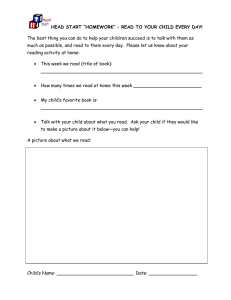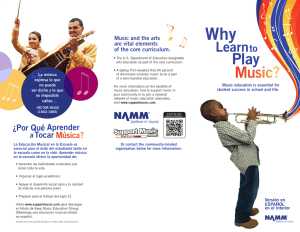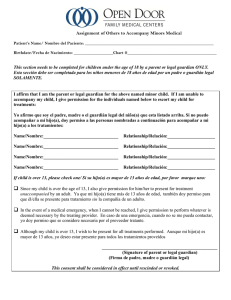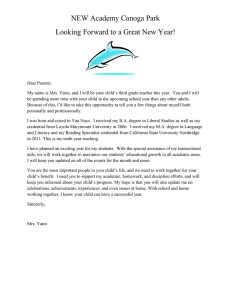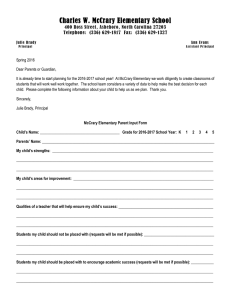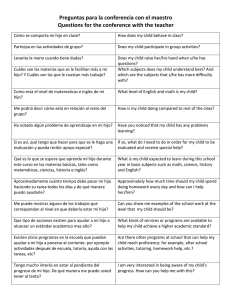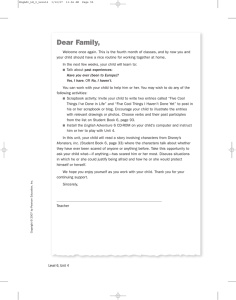Play is Learning - Putnam City Schools
Anuncio
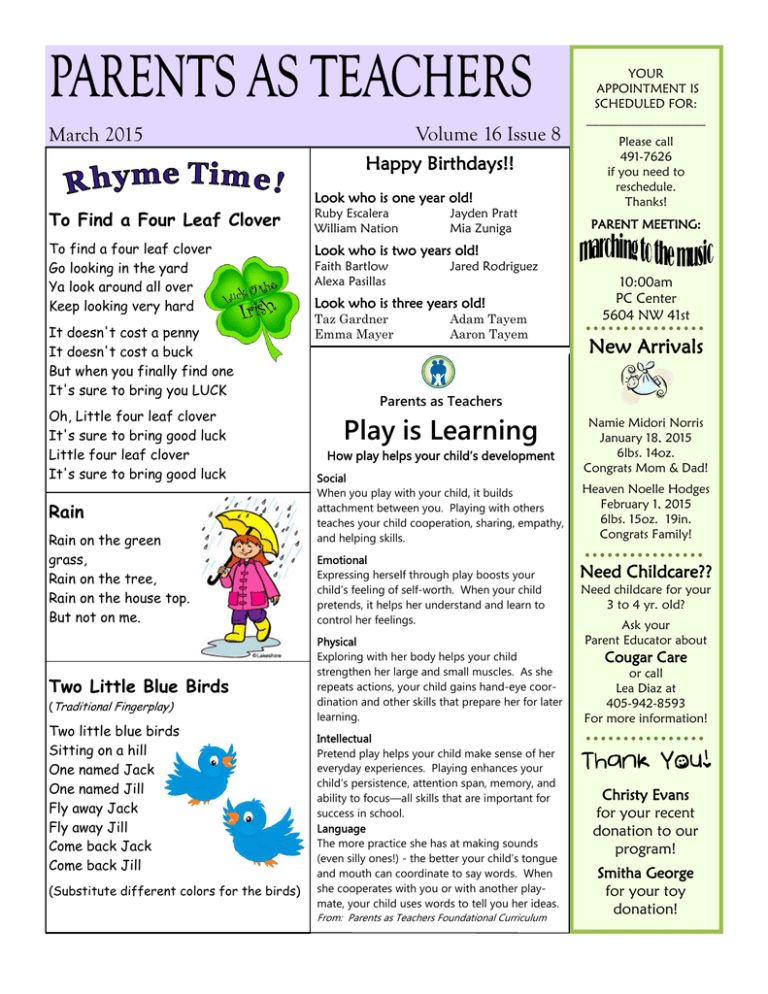
Volume 16 Issue 8 March 2015 Happy Birthdays!! Look who is one year old! To Find a Four Leaf Clover Ruby Escalera William Nation To find a four leaf clover Go looking in the yard Ya look around all over Keep looking very hard Look who is two years old! It doesn't cost a penny It doesn't cost a buck But when you finally find one It's sure to bring you LUCK Oh, Little four leaf clover It's sure to bring good luck Little four leaf clover It's sure to bring good luck Rain Rain on the green grass, Rain on the tree, Rain on the house top. But not on me. Two Little Blue Birds (Traditional Fingerplay) Two little blue birds Sitting on a hill One named Jack One named Jill Fly away Jack Fly away Jill Come back Jack Come back Jill (Substitute different colors for the birds) Faith Bartlow Alexa Pasillas Jayden Pratt Mia Zuniga Please call 491-7626 if you need to reschedule. Thanks! PARENT MEETING: Jared Rodriguez Look who is three years old! Taz Gardner Emma Mayer YOUR APPOINTMENT IS SCHEDULED FOR: ___________________ Adam Tayem Aaron Tayem 10:00am PC Center 5604 NW 41st New Arrivals Parents as Teachers Play is Learning How play helps your child’s development Social When you play with your child, it builds attachment between you. Playing with others teaches your child cooperation, sharing, empathy, and helping skills. Emotional Expressing herself through play boosts your child’s feeling of self-worth. When your child pretends, it helps her understand and learn to control her feelings. Physical Exploring with her body helps your child strengthen her large and small muscles. As she repeats actions, your child gains hand-eye coordination and other skills that prepare her for later learning. Intellectual Pretend play helps your child make sense of her everyday experiences. Playing enhances your child’s persistence, attention span, memory, and ability to focus—all skills that are important for success in school. Language The more practice she has at making sounds (even silly ones!) - the better your child’s tongue and mouth can coordinate to say words. When she cooperates with you or with another playmate, your child uses words to tell you her ideas. From: Parents as Teachers Foundational Curriculum Namie Midori Norris January 18, 2015 6lbs. 14oz. Congrats Mom & Dad! Heaven Noelle Hodges February 1, 2015 6lbs. 15oz. 19in. Congrats Family! Need Childcare?? Need childcare for your 3 to 4 yr. old? Ask your Parent Educator about Cougar Care or call Lea Diaz at 405-942-8593 For more information! Christy Evans for your recent donation to our program! Smitha George for your toy donation! Shamrock Eggs March 6 March to the Music April 11 & 13 Early Birds Registration Required Ingredients: large green bell pepper- sliced butter or oil eggs, small Parmesan cheese Instructions: Slice bell pepper into 1/2-inch whole slices lengthwise. Place in heated skillet with melted butter or oil. Crack egg in the center of bell pepper slice and cook until set, approximately 1 minute. Flip and cook on other side until achieved desired consistency. Garnish with shredded Parmesan cheese. Serve with fruit like green apples and grapes, and toast. April 17 Exploring Music: Ways to Have Fun With Your Child May 1 Day at the Zoo Your child started moving to music before she could even sit up and now she can dance! Children show their enjoyment with their whole bodies. It’s fun—and it’s good for their brains. Your child may not be able to carry a tune, but she does have a singing voice. You will probably hear her singing to herself and making up new songs and words. Repeating words this way helps her learn to understand and speak them. Music helps your child’s brain develop in many ways. You have probably already heard how music helps her talk. It can also help her thinking skills. Your child may remember things more easily when they are set to music. Just think: We all know the ABC song! Teach her songs about counting, colors, and letters. Sensory stimulation Music involves hearing, seeing, feeling, touching, and moving. It makes your child want to get active! When your child moves while learning, she is more likely to remember. Patterns and sequence The repetition in melody and lyrics helps identify patterns, an early skill for reading, math, and memory. Rhythm and melody help your child anticipate what comes next. Social interaction Singing together is a cooperative activity. Your child learns to make eye contact, take the lead, follow directions, and enjoy herself. It also helps her express her own talents and interests, creating a sense of self-worth. Musical activities to do together While your child probably listens to plugged-in entertainment like the radio and CDs, it is best for her brain when you experience music together. It also strengthens the attachment between you. Don’t feel shy about singing or playing music with your child. Your voice will please her because you are the most important person in her life. Drop-in & Play Contact Information: Putnam City Center 491-7626 OPAT Phone Extensions: Kelly Diana Diane Mrs. Reimers Sylvia 1302 1312 1313 1311 1310 If you reach the operator, ask for the extension or after hours you may enter the extension from your phone. OUHSC (Children’s Hospital) is hosting their annual “Green Eggs and Ham” breakfast on Monday, March 2 in honor of Dr. Seuss’ Birthday. Breakfast is $5.00 and is a fundraiser and will be served from 7-10 a.m. But then there are free children’s activities from 93 for families. Hosted in the Atrium. Music often helps toddlers change their mood. Slow music can calm toddlers who are excited or upset. Fast music can get them up and moving. From: Parents as Teachers, Parent Pages Explorar la música: Formas de divertirse con su hijo Su hijo comenzó a moverse al ritmo de la música incluso antes de que pudiera sentarse. ¡Y ahora puede bailar! Los niños demuestran su entusiasmo con todo su cuerpo. Es divertido, y es Bueno para su cerebro. Es posible que su hijo no pueda seguir una melodía, pero tiene una voz para cantar. Probablemente lo oriá cantar para sí mismo e inventar nuevas palabras y canciones. Repetir palabras de esta forma lo ayuda a comprenderlas y pronunciarlas. La música ayuda a que el cerebro de su hijo se desarrolle de muchas maneras. Probablemente ya haya escuchado que le ayuda a hablar. También puede ayudar a su razonamiento. Es posible que su hijo recuerde las cosas más fácilmente cuando se les pone música. Si no piense: ¡todos conocemos la canción del ABC! Enseñele canciones sobre numeros, colores y letras. Estimulación sensorial La música involucra el oído, la vista, los sentimientos, el tacto y el movimiento. ¡Hace que su hijo quiera ponerse en movimiento! Cuando se mueve mientras aprende, es más probable que recuerde lo que aprendió. Patrones y secuencia La repetición de la melodia y las letras ayuda a identificar patrones, una habilidad temprana para la lectura, las matematicas y la memoria. El ritmo y la melodia le ayudan a su hijo a anticipar qué viene después. Interacción social Cantar juntos es una actividad en conjunto. Su hijo aprende a hacer contacto visual, a llevar la iniciativa, seguir indicaciones y disfrutar. También le ayuda a expresar sus propios talentos e intereses, lo que crea un sentimiento de valoración personal. Actividades musicales para hacer juntos Si bien es probable que su hijo escuche música en radio y CD, es major para su cerebro cuando disfrutan juntos de la música. Esto también fortalece el apego entre ambos. No sienta verguenza de cantar o tocar música con su hijo. A su hijo le gusta su voz porque usted es la persona más importante en su vida. A menudo la música ayuda a cambiarles el humor a los niños pequeños. La música suave puede calmar a los niños pequeños cuando están agitados o molestos. La música rápida puede ponerlos en movimiento. Para: Padres como maestros páginas Sun 1 Count 10 “green” objects. Mon 2 Read “What Shall We Do With the Boo-Hoo Baby?” Tue 3 Are your child’s immunizations current? Wed 4 Sing “Row, Row, Row Your Boat”. Thu 5 String cheerios to make a bird feeder. Fri 6 10 AM Parent Mtg. Sat 7 Read “Inside, Outside, Upside Down”. 8 Play with boxes and talk about “in” and “out”. 9 Visit the library. 10 Crawl with your baby. 11 Visit the animals at the zoo. 12 Dance with your baby. 13 Make cookies with your child. 14 Read a book about animals. 15 Spend some quiet time with your family. 16 Practice your fire exit plan. 17 Let your child use tongs to pick up small toys. 18 Work puzzles with your child. 19 Tummy Time! 20 Play in the park. 21 Make trail mix. 22 Toss bean bags with your child. 23 Sing “Head, Shoulders, Knees and Toes”. 24 Read “In A People House”. 25 Talk about the weather with your child. Is it cold or hot, sunny or cloudy? 26 Mix the colors blue and yellow together. 27 Stack blocks and knock them down. 28 Look at family pictures with your child. 29 Paint a rainbow or draw one with sidewalk chalk. 30 Sing “Where Is Thumbkin?” 31 Read “Green Eggs and Ham”. 2015 Winter Session Putnam City School District OPAT P.C. Center 5604 N.W. 41st Oklahoma City, OK 73122
